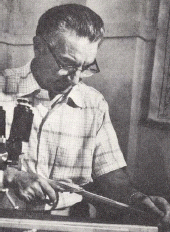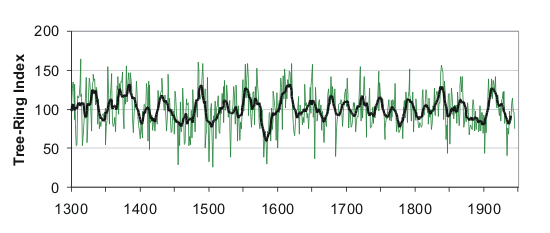Pioneering work in the Colorado River basin (1940s)
The modern science of dendrochronology (tree-ring research) was developed by Andrew Ellicott Douglass (1867-1962), who spent most of his career at the University of Arizona in Tucson. An astronomer who became interested in the impact of solar cycles on climate, Douglass realized that the rings of ponderosa pine trees in Arizona recorded the variation in rainfall from one year to the next. He used the patterns of wide and narrow rings, consistent among trees across the region, to infer past climate conditions and also to date wood from numerous archaeological sites across the Southwest.
O ne of Douglass's foremost students was Edmund Schulman (1908-1958). Schulman conducted extensive fieldwork across western North America to find long-lived conifers whose rings contained the most sensitive and faithful climate records. His most famous discovery was of the incredible longevity of the bristlecone pines (Pinus longaeva) in the Great Basin, over 4000 years old. Back at the Douglass-initiated Laboratory of Tree-Ring Research (LTRR) in Tucson, Schulman made many advances in using these sensitive tree-ring records to reconstruct past climate, and laid the foundation for the science of dendroclimatology.
ne of Douglass's foremost students was Edmund Schulman (1908-1958). Schulman conducted extensive fieldwork across western North America to find long-lived conifers whose rings contained the most sensitive and faithful climate records. His most famous discovery was of the incredible longevity of the bristlecone pines (Pinus longaeva) in the Great Basin, over 4000 years old. Back at the Douglass-initiated Laboratory of Tree-Ring Research (LTRR) in Tucson, Schulman made many advances in using these sensitive tree-ring records to reconstruct past climate, and laid the foundation for the science of dendroclimatology.
Schulman recognized that the moisture-sensitive trees of the Southwest could be used as a proxy for annual streamflow as well as precipitation. In 1942, he issued a report for the Los Angeles Bureau of Power and Light entitled "A tree-ring history of runoff of the Colorado River, 1366-1941". He expanded on this work for his Ph.D. dissertation (1944), and a monograph, "Tree-Ring Hydrology of the Colorado Basin", published by the University of Arizona in 1945.
Schulman's analyses were limited by the lack of computers and less sophisticated statistical techniques at that time. He also sampled many fewer trees at each site than is typically done today. His "history of runoff" was not statistically calibrated and validated against the gage-based streamflow record; instead, he used a tree-ring growth index as a direct proxy for streamflow. These limitations aside, Schulman's pioneering work captured the important features of later streamflow reconstructions of the Colorado River. He also began what has become a long, if sporadic, collaboration between tree-ring scientists and water managers to better understand the variability of the Colorado River.

This graph shows the regional tree-ring index developed by Schulman from several Douglas-fir sites in the Colorado River basin. The long-term mean is set at 100, with values above 100 indicating wider rings (higher streamflow) and value below 100 indicating narrower rings (lower streamflow). The correlation between Schulman's tree-ring index and the Lees Ferry natural flow record from 1906-1945 is fairly high, suggesting that the tree-ring index is indeed a good proxy for streamflow.
Several features of Schulman's tree-ring record are worth noting, as they are seen in later Colorado River streamflow reconstructions. First, the first two decades of 1900s appears to be the longest period of sustained above-average flows since at least the early 1600s. Second, the late 1500s appears to be the most severe and sustained period of below-average flows (that is, drought) in the entire record. Overall, the 20th century (at least through 1945) does not capture the full range of variability--particularly the low flows--seen in the previous six centuries.



